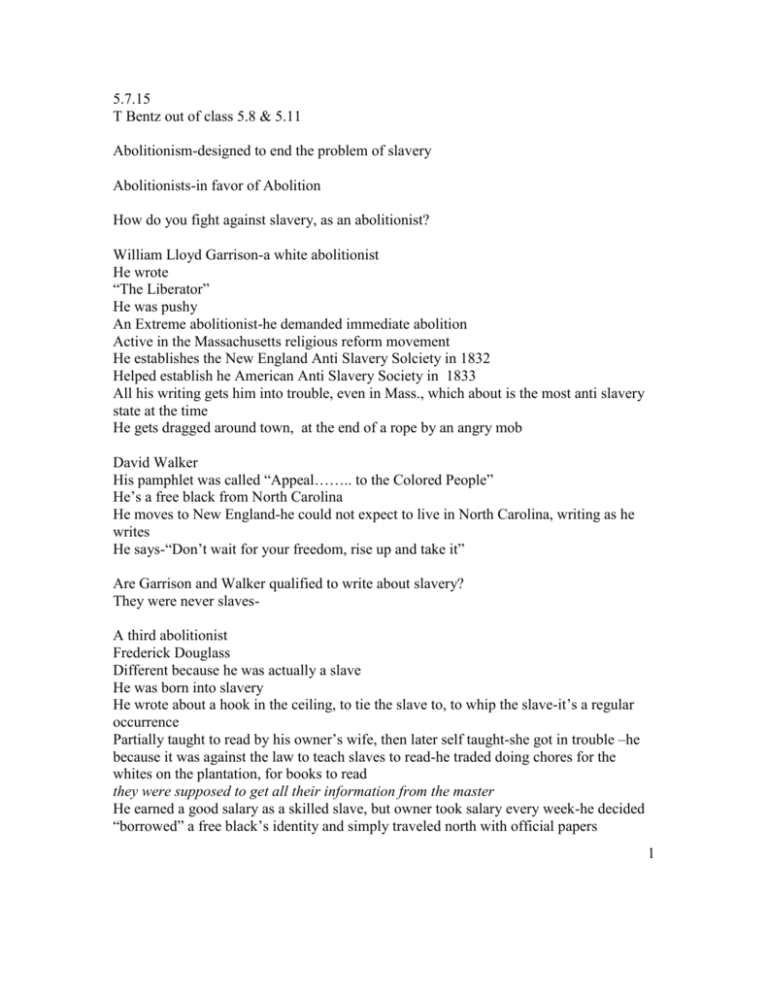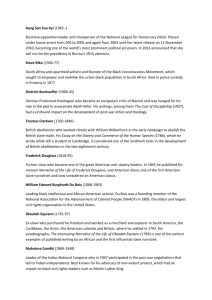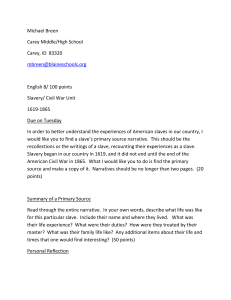Look at the following map
advertisement

5.7.15 T Bentz out of class 5.8 & 5.11 Abolitionism-designed to end the problem of slavery Abolitionists-in favor of Abolition How do you fight against slavery, as an abolitionist? William Lloyd Garrison-a white abolitionist He wrote “The Liberator” He was pushy An Extreme abolitionist-he demanded immediate abolition Active in the Massachusetts religious reform movement He establishes the New England Anti Slavery Solciety in 1832 Helped establish he American Anti Slavery Society in 1833 All his writing gets him into trouble, even in Mass., which about is the most anti slavery state at the time He gets dragged around town, at the end of a rope by an angry mob David Walker His pamphlet was called “Appeal…….. to the Colored People” He’s a free black from North Carolina He moves to New England-he could not expect to live in North Carolina, writing as he writes He says-“Don’t wait for your freedom, rise up and take it” Are Garrison and Walker qualified to write about slavery? They were never slavesA third abolitionist Frederick Douglass Different because he was actually a slave He was born into slavery He wrote about a hook in the ceiling, to tie the slave to, to whip the slave-it’s a regular occurrence Partially taught to read by his owner’s wife, then later self taught-she got in trouble –he because it was against the law to teach slaves to read-he traded doing chores for the whites on the plantation, for books to read they were supposed to get all their information from the master He earned a good salary as a skilled slave, but owner took salary every week-he decided “borrowed” a free black’s identity and simply traveled north with official papers 1 Luckily, he was in Maryland, near Pennsylvania He’s a naturally gifted speaker He’s not impressed with William Lloyd Garrison He hoped for nonviolent end to slavery, broke with Garrison, and began the “North Star” Leading up to the Civil War-the 1850s (Antebellum) Economics Politics Industrialization Democratization the process of Process of becoming industrializing democratic-remember Remember the government Andrew Jackson-he was policy, leading to campaigning to the Industrialization-The “common man” American System He instituted the Spoils 3 parts: System Tariff “Universal White Male National Bank Suffrage”-everyone can Internal Improvements vote, as long as you’re a (Transportation revolution) white male Canals, Erie Canal Steamboat, Trains Moving into the 1850s Moving into the 1850s Compromise of 1850 -California is free In the Constitution, when a slave runs away, he must be returned-the South demands a stronger law -Fugitive Slave Act If you harbored an escaped slave you could be jailedthis angers the North A LOT -Other countries visit, and DC abolishes slave trade - We get Popular Sovereignty-when a territory is ready to become a state, the people who live there vote for slave (applies to Utah and NM territories) Society & Culture Reform Looking at religion-ending predestination Care of the mentally illstarting asylums Moving into the 1850s Enter Harriet Beecher Stowe The daughter of a preacher, and she marries a preacher She goes to Kentucky, returns, and writes a bookTwo things change the way Northerners looked at slavery: 1. Fugitive Slave Act-they may get fine or imprisoned 2. Harriet wrote Uncle Tom’s Cabin 2 Problems of Social Balance in the 1850s. Missouri Compromise 1820 Look at the following map In 1820, we did not have Oregon, Utah, California, NM, and Texas, all we had was the Louisiana Purchase (unorganized territory Minnesota, Iowa, Ark Mo) Missouri wanted to enter the Union, throwing off the slavery balance, so Maine enters to balance the issue (keep the balance between North and South in the Senate-no majority) This way, no bill can get to the President to become a law-the South does not want an anti slavery law 36 30’ rule-if you are a territory south of that line in the Lousiana Terrritory, you become slave, and if north, free-it looks like the North is going to win, due to more territory Compromise of 1850 This begins with California creating difficulties1850, California decides it wants to be a free state-it has enough people, we got it from the treaty with Mexico in 1848 -people flood into California due to the Gold Rush There is no other state to balance.-the government goes crazy California is outside the Louisiana Purchase, so the 36 30 rule does not apply It creates a mess, and California does not want to back down Compromise of 1850 California is free In the Constitution, when a slave runs away, he must be returned-the South demands a stronger law-Fugitive Slave Act If you harbored an escaped slave you could be jailed-this angers the North A LOT Washington DC is a southern city-a lot of other countries, (France, GB), have abolished slavery Other countries visit, and DC abolishes slave trade Texas wants to take Utah, and NM-Texas is already a slave state, California is freeremember the 36 30 rule does not apply 3 We get Popular Sovereignty-when a territory is ready to become a state, the people who live there vote for slave (applies to Utah and NM territories) WE NOW HAVE TWO LAWS GOING, POPULAR SOVEREIGNTY, AND 36 30 RULE-this helps the South-even though the map looks like there’s a possibility to favor the North Enter Harriet Beecher Stowe The daughter of a preacher, and she marries a preacher She goes to Kentucky, returns, and writes a bookTwo things change the way Northerners looked at slavery: 1. Fugitive Slave Act-they may get fine or imprisoned 2. Harriet wrote Uncle Tom’s Cabin Kansas Nebraska Act 1854 Over these years, the South goes from a place where it looks like they’re going to lose, and then they get real pushy 4







